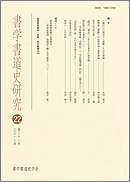2012 巻, 22 号
選択された号の論文の9件中1~9を表示しています
- |<
- <
- 1
- >
- >|
論文
-
2012 年 2012 巻 22 号 p. 1-12
発行日: 2012年
公開日: 2013/06/02
PDF形式でダウンロード (1541K) -
2012 年 2012 巻 22 号 p. 13-26
発行日: 2012年
公開日: 2013/06/02
PDF形式でダウンロード (1544K) -
2012 年 2012 巻 22 号 p. 27-40
発行日: 2012年
公開日: 2013/06/02
PDF形式でダウンロード (1439K) -
2012 年 2012 巻 22 号 p. 41-51
発行日: 2012年
公開日: 2013/06/02
PDF形式でダウンロード (1598K) -
2012 年 2012 巻 22 号 p. 53-68
発行日: 2012年
公開日: 2013/06/02
PDF形式でダウンロード (2443K) -
2012 年 2012 巻 22 号 p. 69-80
発行日: 2012年
公開日: 2013/06/02
PDF形式でダウンロード (1912K) -
2012 年 2012 巻 22 号 p. 81-94
発行日: 2012年
公開日: 2013/06/02
PDF形式でダウンロード (3406K) -
2012 年 2012 巻 22 号 p. 95-112
発行日: 2012年
公開日: 2013/06/02
PDF形式でダウンロード (2325K)
研究ノート
-
2012 年 2012 巻 22 号 p. 113-126
発行日: 2012年
公開日: 2013/06/02
PDF形式でダウンロード (2501K)
- |<
- <
- 1
- >
- >|
